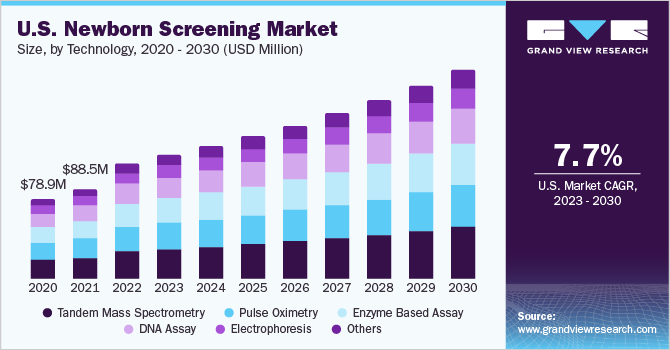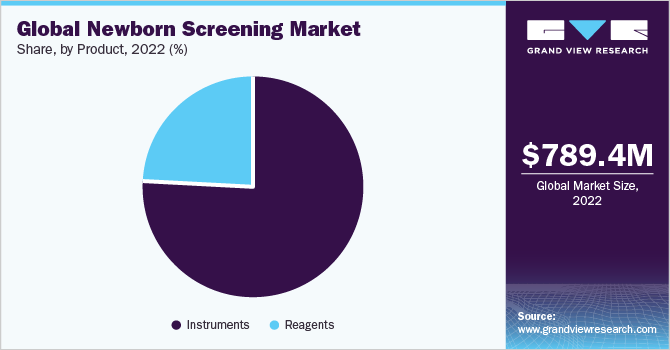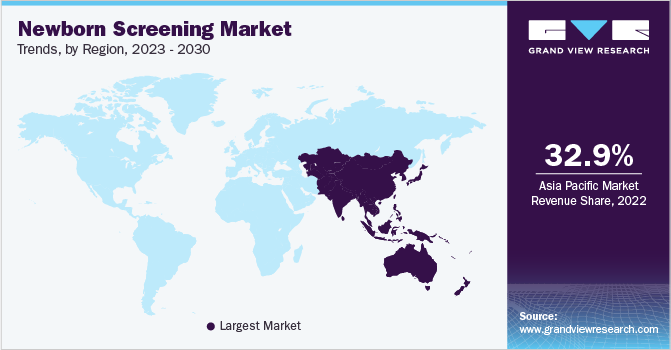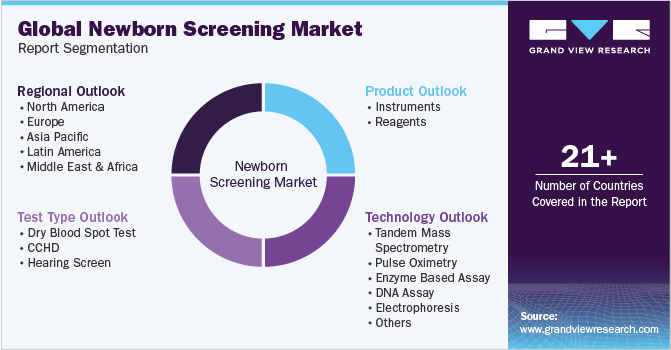- Home
- »
- Clinical Diagnostics
- »
-
Newborn Screening Market Size, Share, Growth Report 2030GVR Report cover
![Newborn Screening Market Size, Share & Trends Report]()
Newborn Screening Market Size, Share & Trends Analysis Report By Technology (Tandem Mass Spectrometry, Pulse Oximetry), By Test Type, By Product (Instruments, Reagents), By Region, And Segment Forecasts, 2023 - 2030
- Report ID: 978-1-68038-490-1
- Number of Report Pages: 180
- Format: PDF, Horizon Databook
- Historical Range: 2018 - 2021
- Forecast Period: 2023 - 2030
- Industry: Healthcare
Report Overview
The global newborn screening market size was valued at USD 789.35 million in 2022 and is expected to grow at a compound annual growth rate (CAGR) of 7.54% from 2023 to 2030.The rising neonatal population, increasing cases of congenital diseases in newborns, growing consumer awareness, and favorable initiatives & support from various governments organizing several programs & legislations are factors estimated to propel market growth over the forecast period. In addition, technological advancements in screening methodologies are also expected to boost the market.

The extensively growing prevalence of congenital diseases in newborns is expected to have a positive impact on the market growth for newborn screening. According to data published by the WHO in February 2023, an estimated 240,000 newborns die within 28 days of birth each year globally due to congenital diseases. Congenital disorders are further responsible for an estimated 170,000 child deaths aged between 1 month and 5 years. In addition, according to information from Indian Pediatrics, congenital hypothyroidism occurs in 2.1 out of every 1,000 infants in India, and the prevalence of inborn metabolic abnormalities ranges from 2-7.8%. Such substantial occurrence of congenital diseases amongst newborns is likely to increase the adoption of tests, which will eventually accelerate market growth by 2030.
In addition, the introduction of government programs and legislation is also expected to offer a favorable environment for the newborn screening industry growth. For instance, in June 2022, the government of Manitoba announced the expansion of its newborn screening program with an aim to extend screening for spinal muscular atrophy along with other diseases. A majority of the nations have statutes for newborn screening, wherein funding for the program, various conditions requiring screening, and exemptions are clearly stated. For instance, the Manitoba government increased its budget by USD 4.2 million to deal with the additional workload of diagnosis.
The demand for newborn screening procedures is expected to be influenced by the introduction of new technologies and availability of treatment options enabling the diagnosis of about 29 possible disorders, including galactosemia (GS), phenylketonuria (PKU), hearing disorders, and congenital hypothyroidism (CH) in neonates. In March 2023, a group of scientists at the Division of Laboratory Sciences, CDC, announced the introduction of improved tests that offer advanced technology for the diagnosis of genetic diseases.
Technology Insights
In 2022, the tandem mass spectrometry segment dominated the market for newborn screening with 24.5% of the revenue share, owing to its cost-effectiveness, higher applicability, and technological upgrades. The tandem mass spectrometry (MS/MS) segment is also likely to expand at a substantial CAGR due to its high efficiency in diagnosing an array of conditions in a single procedure. Furthermore, the development of market players with respect to new products is also expected to accelerate segment growth by 2030. For instance, in April 2023, Waters Corporation announced the launch of its new Xevo TQ Absolute IVD Mass Spectrometer for clinical applications.
The electrophoresis segment is expected to witness significant demand at 8.09% CAGR during the forecast period. This growth is anticipated due to the rising demand for early detection techniques. The growing number of collaborations amongst market players are expected to accelerate segment growth. For instance, in October 2022, CMP Scientific Corp. signed a co-marketing agreement with Agilent for its advanced electrophoresis system.
Test Type Insights
Dry blood spot tests dominated the overall newborn screening market, accounting for over 45.9% of the revenue share in 2022. Moreover, the segment is expected to expand at the fastest CAGR over the forecast period. The DBS test is used for the detection of over 50 conditions that are associated with newborn screening. The growing number of initiatives by government authorities are also projected to accelerate segment growth during the forecast period. For instance, in March 2022, the U.K.-based Oxford University announced the launch of its first pilot study for the diagnosis of spinal muscular atrophy.
The hearing screen segment is expected to register a substantial CAGR during the forecast period. The increasing prevalence of hearing conditions in newborns is estimated to accelerate segment growth during the forecast period. According to a study published by the University of Manchester in 2023, one in 1000 newborn babies suffer from hearing conditions in the U.K.
Product Insights
The instruments segment held the dominant share of 75.91% in the market for newborn screening in 2022 and is expected to advance at the fastest CAGR over the forecast period. The growing number of newborn screening procedures, rising awareness about early disease detection, and increasing investments for newborn screening are estimated to drive the instrument segment during the forecast period. In March 2023, GC Labs announced the launch of its new test for diagnosis of Inborn Errors of Metabolism (IEM) amongst newborns with the incorporation of improved disease detection methods.

The reagent segment is projected to register a significant CAGR during the forecast period. The increasing demand for newborn screening, coupled with growing emphasis on early disease diagnosis amongst newborns, especially in developing countries is offering a lucrative environment for segment growth.
Regional Insights
Asia Pacific accounted for the largest share in the market for newborn screening in 2022, accounting for around 32.90% of the revenue share. Factors such as improving infrastructure and healthcare plans and the availability of new opportunities for expansion are expected to play a major role in driving industry demand over the forecast period. Moreover, owing to the high population density, higher birth rate, and soaring prevalence of congenital diseases, Asia Pacific is expected to be the fastest-growing market for newborn screening techniques.

North America is estimated to expand at a considerable CAGR over the coming years, owing to the growing prevalence of congenital disorders and enforced testing in all the states of the U.S., which are followed diligently. Some of the programs include the Newborn Screening Program, Texas; the California Newborn Screening Program; and the New York State Newborn Screening Program.
Key Companies & Market Share Insights
The industry players are actively involved in strategic partnerships and mergers & acquisitions in order to ensure sustainability. For example, Trivitron Healthcare and Agilent Technologies have partnered to initiate collaboration in the area of high-precision in-vitro diagnostics based on the LC-MS/MS platform. Furthermore, in January 2023, Masimo announced the launch of its new state-of-the-art baby monitoring system. This newly introduced system allows caretakers to monitor the data of babies in real time. Some of the prominent players in the global newborn screening market include:
-
Bio-Rad Laboratories
-
Agilent Technologies
-
Covidien plc
-
Masimo
-
Waters Corporation
-
Natus Medical
-
Trivitron Healthcare
-
GE Lifesciences
-
PerkinElmer Inc
-
AB SCIEX
Newborn Screening Market Report Scope
Report Attribute
Details
Market size value in 2023
USD 842.39 million
Revenue forecast in 2030
USD 1.40 billion
Growth rate
CAGR of 7.54% from 2023 to 2030
Base year for estimation
2022
Historical data
2018 - 2021
Forecast period
2023 - 2030
Report updated
September 2023
Quantitative units
Revenue in USD million/billion and CAGR from 2023 to 2030
Report coverage
Revenue forecast, company ranking, competitive landscape, growth factors, and trends
Segments covered
Product, technology, test type, region
Regional scope
North America; Europe; Asia Pacific; Latin America; Middle East & Africa
Country scope
U.S.; Canada; Germany; U.K.; France; Italy; Spain; Denmark; Sweden; Norway; China; Japan; India; South Korea; Australia; Thailand; Brazil; Mexico; Argentina; South Africa; Saudi Arabia; UAE; Kuwait
Key companies profiled
Agilent Technologies Inc.; AB SCIEX; Natus Medical Inc.; Covidien plc; Trivitron Healthcare; GE Lifesciences; Masimo; Waters Corporation; PerkinElmer Inc.; Bio-Rad Laboratories Inc.
Customization scope
Free report customization (equivalent up to 8 analyst’s working days) with purchase. Addition or alteration to country, regional & segment scope.
Pricing and purchase options
Avail customized purchase options to meet your exact research needs. Explore purchase options
Global Newborn Screening Market Report Segmentation
This report forecasts revenue growth at the global, regional, and country levels and provides an analysis of the latest industry trends in each of the sub-segments from 2018 to 2030. For the purpose of this study, Grand View Research has segmented the global newborn screening market report on the basis of product, technology, test type, and region:

-
Product Outlook (Revenue, USD Million, 2018 - 2030)
-
Instruments
-
Reagents
-
-
Technology Outlook (Revenue, USD Million, 2018 - 2030)
-
Tandem Mass Spectrometry
-
Pulse Oximetry
-
Enzyme Based Assay
-
DNA Assay
-
Electrophoresis
-
Others
-
-
Test Type Outlook (Revenue, USD Million, 2018 - 2030)
-
Dry Blood Spot Test
-
CCHD
-
Hearing Screen
-
-
Regional Outlook (Revenue, USD Million, 2018 - 2030)
-
North America
-
U.S.
-
Canada
-
-
Europe
-
Germany
-
U.K.
-
France
-
Italy
-
Spain
-
Sweden
-
Denmark
-
Norway
-
-
Asia Pacific
-
Japan
-
China
-
India
-
Australia
-
Thailand
-
South Korea
-
-
Latin America
-
Brazil
-
Mexico
-
Argentina
-
-
Middle East and Africa (MEA)
-
South Africa
-
Saudi Arabia
-
UAE
-
Kuwait
-
-
Frequently Asked Questions About This Report
b. The global newborn screening market size was estimated at USD 789.35 million in 2022 and is expected to reach USD 842.39 million in 2023.
b. The global newborn screening market is expected to grow at a compound annual growth rate of 7.54% from 2023 to 2030 to reach USD 1.40 billion by 2030.
b. Instruments dominated the newborn screening market with a share of 75.91% in 2022. This is attributable to the high market penetration of instruments with respect to adoption and price.
b. Some key players operating in the newborn screening market include Agilent Technologies Inc., Natus Medical Inc., Covidien Plc, Trivitron Healthcare, GE Healthcare, Masimo Corp., AB Sciex LLC, Waters Corp., PerkinElmer Inc. and Bio-Rad Laboratories Inc.
b. Key factors that are driving the market growth include introduction of laws and guidelines on implementing newborn screening programs as a mandate program across the globe coupled with technology advanced products to conduct newborn screening.
Share this report with your colleague or friend.
![gvr icn]()
NEED A CUSTOM REPORT?
We can customize every report - free of charge - including purchasing stand-alone sections or country-level reports, as well as offer affordable discounts for start-ups & universities. Contact us now
![Certified Icon]()
We are GDPR and CCPA compliant! Your transaction & personal information is safe and secure. For more details, please read our privacy policy.
We are committed towards customer satisfaction, and quality service.
"The quality of research they have done for us has been excellent."





